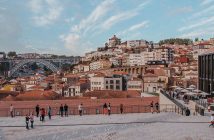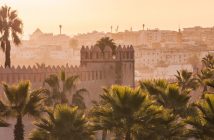‘Asciutto’ – the dry, indifferent and sometimes blunt stereotype the Genoese locals use to describe themselves. But get to know this colourful city in the north of Italy and you’ll soon discover there is nothing but warmth radiating from every corner.
Genoa has seen great tragedy recently; but it is a brilliant city, grossly overlooked in favour of its more famous Italian neighbours that decorate the Ligurian coast. Despite the large cruise ships that bring tourists to Genoa’s shores daily, this coastal haven has managed to retain its Italian soul.
Space is a rarity in Genoa, but also a huge part of the city’s charm. The roads are narrow and winding, with layer upon layer of colourful building blocks that ascend high into the hills. For if you cannot build outwards, you must go up – and that’s precisely what Genoa has done. Exploring the city is best done by foot, or scooter if you dare to be part of the 200,000 zipping in and out of the city streets. Segway tours are also gaining popularity as a modern, faster way to navigate your way through Genoa’s historic past.
 Genoa was seen as a maritime trading powerhouse during medieval times, and its wealth from this period is still evident throughout the city. Grand palazzis, churches and cathedrals with ornate interiors can be found around just about every corner. Even the passive aggressive rivalries of aristocratic families can been still be felt today where one church is overshadowed by a bigger, grander neighbouring establishment almost within touching distance.
Genoa was seen as a maritime trading powerhouse during medieval times, and its wealth from this period is still evident throughout the city. Grand palazzis, churches and cathedrals with ornate interiors can be found around just about every corner. Even the passive aggressive rivalries of aristocratic families can been still be felt today where one church is overshadowed by a bigger, grander neighbouring establishment almost within touching distance.
This was the birthplace of blue jeans, explorer Christopher Columbus and the cross of Saint George – not to mention the first quantified recipe for pesto, but more on food in a moment. Genoa’s history begins at its Porto Antico, which has been given a modern overhaul by native architect Renzo Piano, who designed the aquarium and biosphere that can be enjoyed near the harbour. To their left, you’ll find the Bigo, which is well worth 15 minutes of your time for a panoramic view of Genoa’s waterfront from up high. And if you care to, strap on your trainers and join the Genoese locals for a morning run along the harbour – and be assured the views will not disappoint.
With its gorgeous architecture and unusual structure, Genoa is teeming with spectacular views. Funicolars are scattered across the city and are a novel experience to take in the surroundings. Take the Liberty elevator up to Spianata Castelletto, a public balcony that will help you to really grasp Genoa’s multi-layered personality.
Jump in the Montegalletto elevator to reach the Castello D’Albertis, an 18th-century castle built by Captain Enrico Alberto D’Albertis on 16th-century fortifications. Not only does the castle offer breath-taking views

Columbus House
of Genoa, it also houses a museum – Museo delle Culture del Mondo – which explores a selection of different cultures from around the world.
Inland you’ll also find Genoa’s grey-and-white-striped cathedral. The building was bombed in World War II, but the shell that hit failed to explode. As such, the building remains mostly intact, save for the marked ceiling that can found inside. Just a short walk past the cathedral stands the Porta Soprana gate, which leads to a reconstruction of the building that was once home to the man who discovered the Americas – Christopher Columbus.
Genoa is littered with numerous museums that are worth paying a visit to if you have a few hours to spare: the Galata Museo del Mare is a fascinating exploration of Genoa’s maritime past, and the growth of immigration to and from the city; or the Galleria Nazionale di Palazzo Spinola, a stunning 16th-century palace packed with works by Genoese, Flemish and European artists.
But as with much of Italy, Genoa’s greatest appeal, perhaps, is the food. Join the locals for a typical Genoese breakfast: crisp, chewy focaccia bread dunked in a creamy cappuccino or coffee; a salty/sweet heaven that’s best enjoyed at Pasticceria Cavo Marescotti, part of the city’s collection of historic shops.
Make time for lunch at Le Rune Ristorante. Taking a shabby chic approach to décor, staff will make you feel immediately at home – and the dishes will make you reluctant to leave. The leek and courgette quiche with toasted pine nuts, tender roasted octopus with olive tapenade and traditional trofie pasta with pesto, potatoes and green beans, will be sure to satiate your palate. Just be sure to leave room for something sweet, whether it be a silky crème brulée or tiramisu with orange caramel.

Soul Kitchen is Genoese casual dining at its best – and a great spot for vegetarians and vegans, too. Tucked down a small side street, Soul Kitchen has a medieval feel once you’re buzzed inside thanks to its exposed brickwork, wooden seats and iron details. It also serves the creamiest spaghetti carbonara you can imagine.
While you’re here, it’s well worth learning to cook like an Italian, too. One of the popular local dishes is ‘cappon magro’, a typical fish salad, which can be mastered in just a couple of hours at one of the 42 Unesco-listed Palazzi dei Rolli adorning Via Garibaldi. With its opulent interiors, inside Palazzo Imperiale you’ll find Creattivando Art & Food, and learn how to construct this relatively simple, yet delicious, local favourite.

The old mariners’ neighbourhood of Boccadasse
For a change of scene from the historic city centre, head to the Albaro Arena Village one evening. Also home to five swimming pools, a diving centre and tennis courts if you prefer food and drink over sports, there’s a younger, more energetic atmosphere to be enjoyed here. Stop off at Piazza 32 for an aperitivo before dinner – you might need one while you ponder the myriad dining options before you: Muscoli for muscles; Camugin for Ligurian street food; seasonal dishes from the Piccola Bristrot Mediterraneo – the list goes on.
But one of my favourite parts of Genoa, however, sits a stone’s throw from the city centre: Boccadasse. We start the day with a boat trip that sets sail from Porto Antico (the crew are fabulous, but be sure to pack your waterproofs and a strong stomach). With the day’s catch sorted, it’s a short drive to Boccadasse. We wander along the promenade before descending into the tiny fishing village and into GE8317, a fish bar and restaurant on Via Aurora. GE8317 is adored for its fresh seafood dishes. The boat trip we trialled earlier that day supplies the restaurant’s fish, so the menu can differ depending on what’s been caught – crunchy calamari, mussels, anchovies, and more.

Back in Genoa city centre, there’s one last recommendation to round off any trip. Genoa is littered with historic shops which offer the most charming of shopping experiences. Pietro Romanengo fu Stefano dates back to 1780 and has been selling sweets, candied fruit and chocolate to passers-by ever since. There are myriad butchers and customers queuing out the door for their pound of tripe, hugely popular in the city. Gelateria Profumo offers arguably the best ice cream in Genoa, but there are multiple authentic ice cream parlours to be found around every corner. Or gentlemen, book an appointment in Barberia Giacalone, a 10m2 Art Nouveau-decorated barber tucked away in the heart of the old quarter, for the most suave beard trim/haircut of your life.
Genoa, so far, may not have received the same love and recognition as its better-known Italian regions, but it’s high time the city became the country’s go-to weekend getaway.
For more information on things to do and see in Genoa, visit www.visitgenoa.it.
British Airways flights from London Gatwick to Genoa start from £28 each way, and rooms at the luxurious Hotel Bristol start from €119 per night.
Photos by the author.




